-
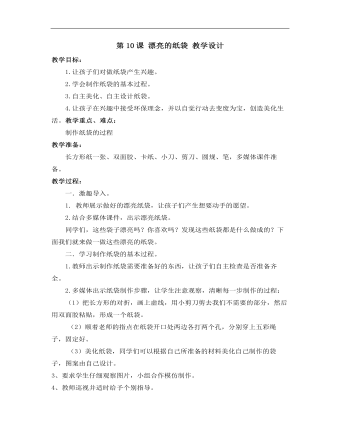
小学美术桂美版三年级上册《第10课漂亮的纸袋》教学设计说课稿
一.激趣导入。 1. 教师展示做好的漂亮纸袋,让孩子们产生想要动手的愿望。 2.结合多媒体课件,出示漂亮纸袋。 同学们,这些袋子漂亮吗?你喜欢吗?发现这些纸袋都是什么做成的?下面我们就来做一做这些漂亮的纸袋。 二.学习制作纸袋的基本过程。 1.教师出示制作纸袋需要准备好的东西,让孩子们自主检查是否准备齐全。 2.多媒体出示纸袋制作步骤,让学生注意观察,清晰每一步制作的过程: (1)把长方形的对折,画上虚线,用小剪刀剪去我们不需要的部分,然后用双面胶粘贴,形成一个纸袋。
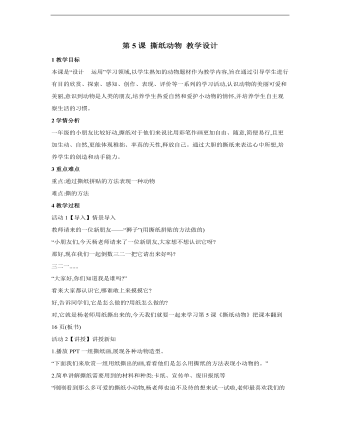
小学美术桂美版一年级上册《第5课撕纸动物》教学设计说课稿
2学情分析 一年级的小朋友比较好动,撕纸对于他们来说比用彩笔作画更加自由、随意,简便易行,且更加生动、自然,更能体现稚拙、率真的天性,释放自己。通过大胆的撕纸来表达心中所想,培养学生的创造和动手能力。3重点难点 重点:通过撕纸拼贴的方法表现一种动物难点:撕的方法
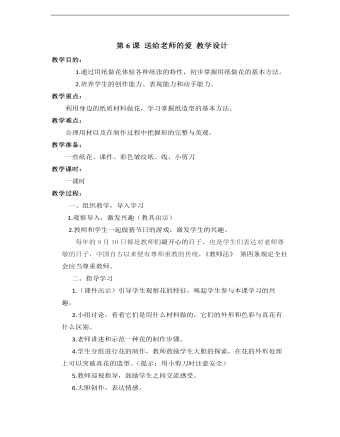
小学美术桂美版一年级上册《第6课送给老师的爱》教学设计说课稿
教学过程:一、组织教学,导入学习1.观察导入,激发兴趣(教具出示)2.教师和学生一起做猜节日的游戏,激发学生的兴趣。 每年的9月10日都是教师们最开心的日子,也是学生们表达对老师尊敬的日子,中国自古以来便有尊师重教的传统,《教师法》 第四条规定全社会应当尊重教师。
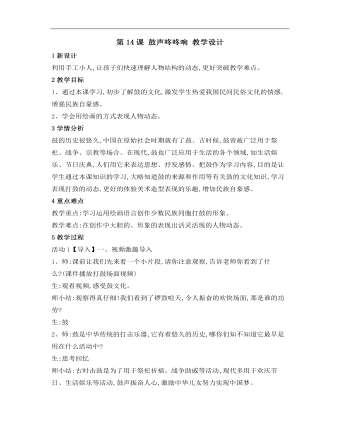
小学美术桂美版三年级上册《第14课鼓声咚咚响3》教学设计说课稿
3学情分析 鼓的历史很悠久,中国在原始社会时期就有了鼓。古时候,鼓曾被广泛用于祭祀、战争、宗教等场合。在现代,鼓也广泛应用于生活的各个领域,如生活娱乐、节日庆典,人们用它来表达思想、抒发感情。把鼓作为学习内容,目的是让学生通过本课知识的学习,大略知道鼓的来源和作用等有关鼓的文化知识,学习表现打鼓的动态,更好的体验美术造型表现的乐趣,增加民族自豪感。4重点难点 教学重点:学习运用绘画语言创作少数民族同胞打鼓的形象。教学难点:在创作中大胆的、形象的表现出活灵活现的人物动态。
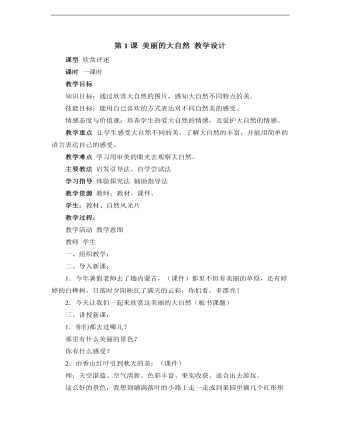
小学美术桂美版一年级上册《第1课美丽的大自然》教学设计说课稿
教学目标 知识目标:通过欣赏大自然的图片,感知大自然不同特点的美。 技能目标:能用自己喜欢的方式表达对不同自然美的感受。 情感态度与价值观:培养学生热爱大自然的情感,及爱护大自然的情感。 教学重点让学生感受大自然不同的美,了解大自然的丰富,并能用简单的语言表达自己的感受。 教学难点学习用审美的眼光去观察大自然。 主要教法启发引导法、自学尝试法 学习指导体验探究法辅助指导法 教学资源教师:教材、课件。 学生:教材、自然风光片 教学过程: 教学活动教学意图 教师学生
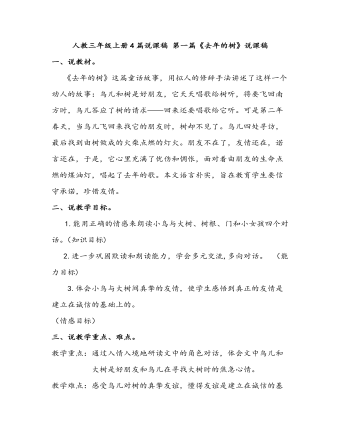
人教版三年级上册语文说课稿
二、说教学目标。 1.能用正确的情感来朗读小鸟与大树、树根、门和小女孩四个对话。(知识目标) 2.进一步巩固默读和朗读能力,学会多元交流,多向对话。 (能力目标) 3.体会小鸟与大树间真挚的友情,使学生感悟到真正的友情是建立在诚信的基础上的。

部编版六年级语文上册《草原》教案
(1)思考:作者是按什么顺序写的?写了哪些内容?明确:作者是按事情发展的先后顺序来写的。首先描述了一望无际的草原美景,使人感受到了一种境界美;接着又展示了主人欢迎远方客人的隆重场面;最后把酒话别,用“蒙汉情深何忍别,天涯碧草话斜阳”来收束全文。(板书:初到草原——远迎客人——热情相见——盛情款待——联欢话别)作者笔下的草原给你留下了什么印象?(学生讨论、交流自己的印象,可与读此文之前对草原的印象进行对比并探讨。)
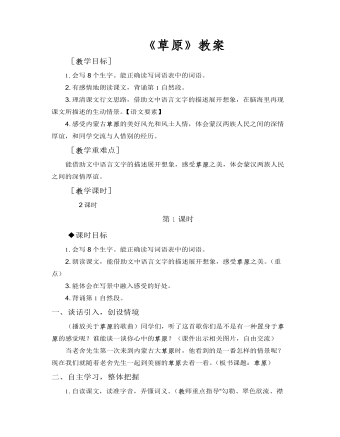
部编版六年级语文上册《草原》教案
1.会写8个生字。能正确读写词语表中的词语。2.朗读课文,能借助文中语言文字的描述展开想象,感受草原之美。(重点)3.能体会在写景中融入感受的好处。4.背诵第1自然段。一、谈话引入,创设情境(播放关于草原的歌曲)同学们,听了这首歌你们是不是有一种置身于草原的感觉呢?谁能谈一谈你心中的草原?(课件出示相关图片,自由交流)当老舍先生第一次来到内蒙古大草原时,他看到的是一番怎样的情景呢?现在我们就随着老舍先生一起到美丽的草原去看一看。(板书课题:草原)
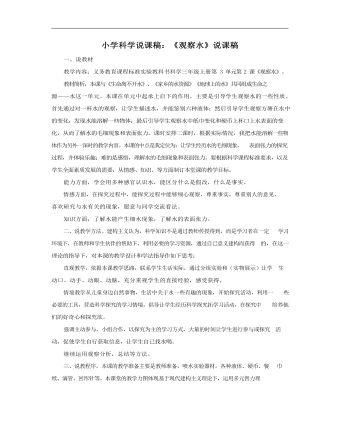
说课稿科学三年级上册《观察水》
二、说教学方法。建构主义认为,科学知识不是通过教师传授得到,而是学习者在一定 学习环境下,在教师和学生伙伴的帮助下,利用必要的学习资源,通过自已意义建构而获得 的,在这一理论的指导下,对本课的教学设计和学法指导作如下思考:直观教学,依据本课教学思路,联系学生生活实际,通过分组实验和(实物展示)让学 生动口、动手、动眼、动脑,充分重视学生的直接经验,感受获得。情境教学从儿童身边自然事物,生活中关于水一些有趣的现象,开始探究活动,利用一 些必要的工具,营造科学探究的学习情境,倡导让学生经历科学探究拓学习活动,在探究中 培养他们的好奇心和探究欲。
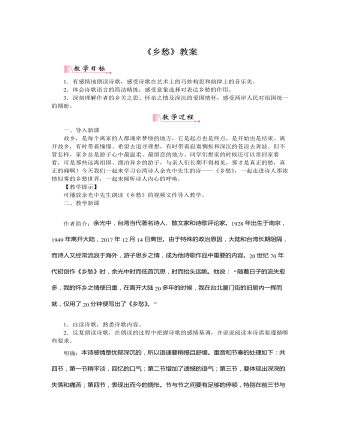
部编版语文九年级上册《乡愁》教案
【教学提示】教师可以示范分析其中两个意象,注意引导学生把握普通事物之所以形成诗歌意象的原因,领悟诗歌意象的内蕴意义。3.诗人在诗中运用了许多表修饰、限制的形容词和数量词,它们有什么特点?它们共同突出了诗歌中四个意象的什么特征?请你简要说说它们在诗歌中的表达效果。明确:“一枚”“一张”“一方”“一湾”四个数量词和“小小的”“窄窄的”“矮矮的”“浅浅的”四个形容词,都是面积小重量轻的词语。然而,邮票虽小,却承载了母子深情;船票虽窄,却联系着夫妻之间浓浓的恋情;矮矮的坟墓,盛不下生死离情之痛;海峡虽浅,隔断的思乡哀愁却是如此之深。这一系列限定修饰词,都反衬了乡愁的浓郁。目标导学四:把握诗歌艺术特征探究:本诗除了在意象选取上颇费心思,在结构艺术上也见出笔力。请同学们说说,本诗还具有哪些令你欣赏的艺术特征。
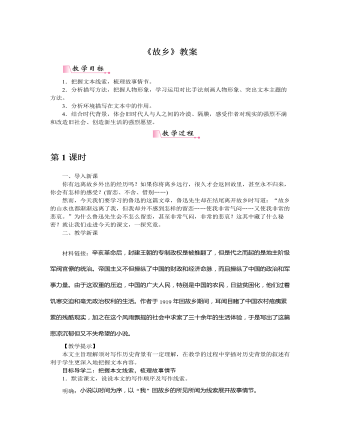
部编版语文九年级上册《故乡》教案
【分析杨二嫂形象】1.昔日的杨二嫂是怎样的一个形象?明确:昔日被称作“豆腐西施”,“擦着白粉”“终日坐着”,是一个安分守己的妇女形象。2.如今的杨二嫂是怎样的形象?作者是从哪些方面刻画的?明确:“凸颧骨”“薄嘴唇”“圆规”等肖像描写,“尖利的怪声”“大叫”“两手搭在髀间”“贵人眼高”等动作和语言描写,表现出了杨二嫂泼悍、放肆、尖刻的性格特征。讨东西、造谣、塞手套又表现出她的自私、泼悍、爱贪小便宜。探究:作者塑造杨二嫂这一形象有什么作用?杨二嫂的形象是作者“悲哀”的源头吗?明确:杨二嫂的变化说明了辛亥革命后,城镇小市民阶层的贫困化,反映了当时社会经济破产的广度和深度。杨二嫂的变化,是不合理制度下的人性转变,如果说闰土是“精神麻木”的状态让作者觉得“悲哀”,那么杨二嫂便是因为失去真善美的人性而使作者觉得“悲哀”。
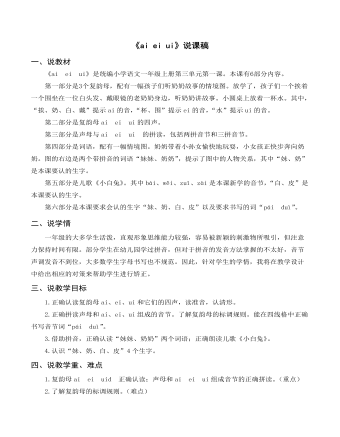
部编人教版一年级上册《ai ei ui》说课稿
一、说教材《ai?ei?ui》是统编小学语文一年级上册第三单元第一课。本课有6部分内容。第一部分是3个复韵母,配有一幅孩子们听奶奶故事的情境图。放学了,孩子们一个挨着一个围坐在一位白头发、戴眼镜的老奶奶身边,听奶奶讲故事。小圆桌上放着一杯水。其中,“挨、奶、白、戴”提示ai的音,“杯、围”提示ei的音,“水”提示ui的音。第二部分是复韵母ai?ei?ui的四声。第三部分是声母与ai?ei?ui?的拼读,包括两拼音节和三拼音节。第四部分是词语,配有一幅情境图。奶奶带着小孙女愉快地玩耍,小女孩正快步奔向奶奶。图的右边是两个带拼音的词语“妹妹、奶奶”,提示了图中的人物关系,其中“妹、奶”是本课要认的生字。第五部分是儿歌《小白兔》。其中bái、wěi、zuǐ、zài是本课新学的音节,“白、皮”是本课要认的生字。第六部分是本课要求会认的生字“妹、奶、白、皮”以及要求书写的词“pái?duì”。
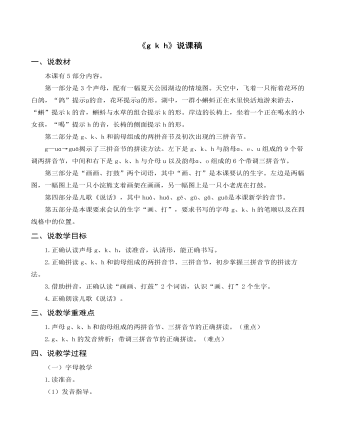
部编人教版一年级上册《g k h》说课稿
2.识记形。(1)观察字形。除了引导学生从情境图中花环、水草和蝌蚪的组合、椅子的侧面等帮助记忆ɡ、k、h的形体外,还要引导学生充分发挥想象来记忆,教师在课前也可以收集一些图片帮助学生记忆。(2)书写字母。声母ɡ、k、h书写指导时,要注意两个新的笔画名称,“”叫竖左弯,“”叫左斜右斜。教师可边示范边讲清字母书写的笔顺和在四线三格中的位置。ɡ两笔写成,占中格和下格。书写时要注意“”的竖要写得直。k两笔写成,占上格和中格。书写时注意“”是一笔完成。h两笔写成,占上格和中格。书写时要注意第一笔竖要占到上格,和n的字形区分开来。(二)拼读教学1.两拼音节。教师要引导学生运用前面所学的方法自己拼读两拼音节,先个体拼读,然后和同伴互相评议。对学生不易区分的ɡù、kǔ、hǔ,教师要加以重点指导。拼读练习时,要和学生熟悉的汉字、事物联系起来,也可以进行适度的拓展,增强趣味性。如:2.三拼音节。这是学生第一次接触三拼音节,拼读难度较大。教师要借助拼读示意图讲清拼读规则,然后联系学生熟悉的事物以及识字单元中已学的“火”字,帮助学生正确拼读,降低难度。
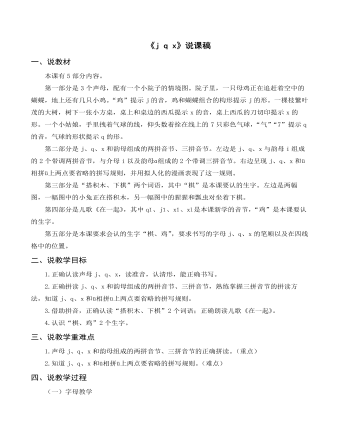
部编人教版一年级上册《j q x》说课稿
本课有5部分内容。第一部分是3个声母,配有一个小院子的情境图。院子里,一只母鸡正在追赶着空中的蝴蝶,地上还有几只小鸡。“鸡”提示j的音,鸡和蝴蝶组合的构形提示j的形。一棵枝繁叶茂的大树,树下一张小方桌,桌上和桌边的西瓜提示x的音,桌上西瓜的刀切印提示x的形。一个小姑娘,手里拽着气球的线,仰头数着拴在线上的7只彩色气球,“气”“7”提示q的音,气球的形状提示q的形。第二部分是j、q、x和韵母组成的两拼音节、三拼音节。左边是j、q、x与韵母i组成的2个带调两拼音节,与介母i以及韵母ɑ组成的2个带调三拼音节。右边呈现j、q、x和ü相拼ü上两点要省略的拼写规则,并用拟人化的漫画表现了这一规则。第三部分是“搭积木、下棋”两个词语,其中“棋”是本课要认的生字。左边是两幅图,一幅图中的小兔正在搭积木,另一幅图中的猩猩和瓢虫对坐着下棋。第四部分是儿歌《在一起》,其中qǐ、jī、xǐ、xì是本课新学的音节,“鸡”是本课要认的生字。第五部分是本课要求会认的生字“棋、鸡”,要求书写的字母j、q、x的笔顺以及在四线格中的位置。二、说教学目标1.正确认读声母j、q、x,读准音,认清形,能正确书写。2.正确拼读j、q、x和韵母组成的两拼音节、三拼音节,熟练掌握三拼音节的拼读方法,知道j、q、x和ü相拼ü上两点要省略的拼写规则。3.借助拼音,正确认读“搭积木、下棋”2个词语;正确朗读儿歌《在一起》。4.认识“棋、鸡”2个生字。
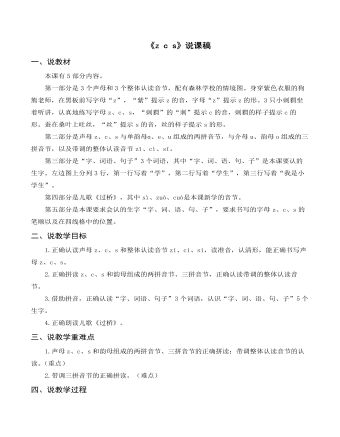
部编人教版一年级上册《z c s》说课稿
一、说教材本课有5部分内容。第一部分是3个声母和3个整体认读音节,配有森林学校的情境图。身穿紫色衣服的狗熊老师,在黑板前写字母“z”,“紫”提示z的音,字母“z”提示z的形。3只小刺猬坐着听讲,认真地练写字母z、c、s,“刺猬”的“刺”提示c的音,刺猬的样子提示c的形。蚕在桑叶上吐丝,“丝”提示s的音,丝的样子提示s的形。第二部分是声母z、c、s与单韵母ɑ、e、u组成的两拼音节,与介母u、韵母o组成的三拼音节,以及带调的整体认读音节zǐ、cì、sī。第三部分是“字、词语、句子”3个词语,其中“字、词、语、句、子”是本课要认的生字。左边图上分列3行,第一行写着“学”,第二行写着“学生”,第三行写着“我是小学生”。第四部分是儿歌《过桥》,其中sì、zuò、cuò是本课新学的音节。第五部分是本课要求会认的生字“字、词、语、句、子”,要求书写的字母z、c、s的笔顺以及在四线格中的位置。
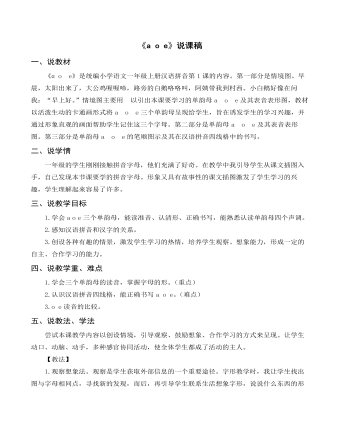
部编人教版一年级上册《a o e》说课稿
一、说教材《ɑ o?e》是统编小学语文一年级上册汉语拼音第1课的内容。第一部分是情境图。早晨,太阳出来了,大公鸡喔喔啼,路旁的白鹅咯咯叫,阿姨带我到村西。小白鹅好像在问我:“早上好。”情境图主要用?以引出本课要学习的单韵母a?o?e及其表音表形图,教材以活泼生动的卡通画形式将a?o?e三个单韵母呈现给学生,旨在诱发学生的学习兴趣,并通过形象直观的画面帮助学生记住这三个字母。第二部分是单韵母a?o?e及其表音表形图。第三部分是单韵母a?o?e的笔顺图示及其在汉语拼音四线格中的书写。二、说学情一年级的学生刚刚接触拼音字母,他们充满了好奇。在教学中我引导学生从课文插图入手,自己发现本节课要学的拼音字母。形象又具有故事性的课文插图激发了学生学习的兴趣,学生理解起来容易了许多。三、说教学目标1.学会a o e 三个单韵母,能读准音、认清形、正确书写,能熟悉认读单韵母四个声调。2.感知汉语拼音和汉字的关系。3.创设各种有趣的情景,激发学生学习的热情,培养学生观察、想象能力,形成一定的自主、合作学习的能力。

部编人教版一年级上册《江南》说课稿
三、说教学目标1.指导学生认识“江、南、可、等”9个生字。会写“可、东、西”3个字。学习新笔画“竖弯钩”“竖弯”。? 2.引导学生正确流利地朗读课文。背诵课文。感悟江南水乡的美景。? 3.培养学生热爱大自然的感情。四、说教学重难点1.让学生通过识字,能正确流利地读、背古诗。(重点)?2.感悟江南水乡的美景,培养学生热爱大自然的情感。(难点)五、说教法和学法教学是教师和学生互动的一个双边活动,在这个活动中教师是学习的组织者、引导者、合作者,而学生才是学习的主体,因此本节课我采用了“激、促、查、教”等教学方法,指导学生在“自主、合作”中学习,以达到“生成知识、运用知识”的目的。
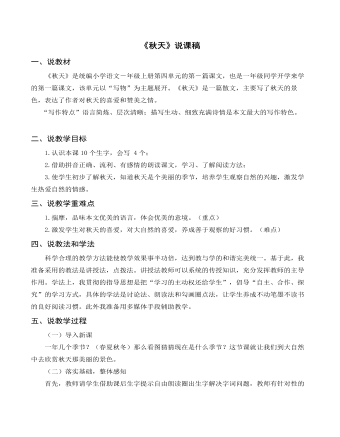
部编人教版一年级上册《秋天》说课稿
一、说教材《秋天》是统编小学语文-年级上册第四单元的第-篇课文,也是一年级同学开学来学的第一篇课文,该单元以“写物”为主题展开。《秋天》是一篇散文,主要写了秋天的景色,表达了作者对秋天的喜爱和赞美之情。 “写作特点”语言简炼、层次清晰;描写生动、细致充满诗情是本文最大的写作特色。 二、说教学目标1.认识本课10个生字,会写 4个;2.借助拼音正确、流利、有感情的朗读课文,学习、了解阅读方法;3.使学生初步了解秋天,知道秋天是个美丽的季节,培养学生观察自然的兴趣,激发学生热爱自然的情感。

部编人教版一年级上册《项链》说课稿
四、说教学重难点1.正确、流利地朗读课文,能合理搭配“的”字词语。(重点)?2.感受大海的美丽,知道大海的项链是什么,体会小娃娃海边玩耍的快乐。(难点)五、说教法和学法俗话说:”教无定法,贵在得法”。教学是师生之间、学生之间交往互动、共同发展的过程。建构主义理论强调以学生为中心,强调学生对知识的主动探索、主动发现和对所学知识的主动建构。在教学这一过程中,学生是学习的中心,教师在整个教学过程中起组织者、指导者、帮助者和促进者的作用。? 因此,遵循学生的认知规律,突出教师为主导,学生为主体的教学原则,本节课主要采用学案导学、闯关游戏、小组竞赛的方式进行学习。教师主要为学生创设问题情境,引导学生在对话、讨论、交流中觅取新知,启发、点拨学生通过分析人物的心理描把握人物形象、领悟小说主旨。为了提高课堂学习效果,主要利用多媒体课件和学案来进行教学。
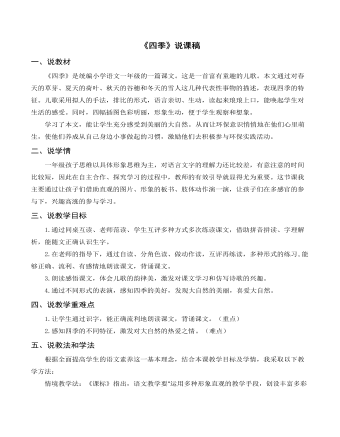
部编人教版一年级上册《四季》说课稿
五、说教法和学法根据全面提高学生的语文素养这一基本理念,结合本课教学目标及学情,我采取以下教学方法:情境教学法:《课标》指出,语文教学要“运用多种形象直观的教学手段,创设丰富多彩的教学情境”。本节课,我通过创设一定情境,激发学生学习兴趣,集中其注意力,拉近学生与文本的距离。以读代讲:本着“以读为本”的教学原则,让学生通过读对课文加深理解,并在图片美的直观感受下读出感情,学生就能进一步的感受感受到语句的优美。叶圣陶先生指出,“教师之为教,不在于全盘授予,而在相机诱导”。学习中突出学生的主体地位,让学生放开手脚,积极参与。本课我指导学生用如下方法进行学习:朗读感悟法:《课标》指出小学各年级的阅读教学都要重视朗读。要让学生充分的读,在读中整体感知,在读中有所感悟,在读中培养语感,在读中受到情感的熏陶。本节课,我让学生通过多种形式的读来感受文中蕴涵的情感。自主合作学习方法:合作学习,培养学生合作意识和自主学习能力。

